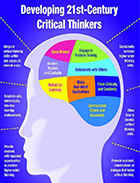Brainstorming – The Road to Creative Solutions
Brainstorming – The Road to Creative Solutions
 A traditional classroom does not provide much scope for interaction between the students and the teacher. Many new methods have been developed to make learning a two-way process. Group discussions, presentations, role playing, dramatisation are all modern methods of effective classroom engagement. Another effective method that has been around for quite some time is the process of ‘brainstorming’.
A traditional classroom does not provide much scope for interaction between the students and the teacher. Many new methods have been developed to make learning a two-way process. Group discussions, presentations, role playing, dramatisation are all modern methods of effective classroom engagement. Another effective method that has been around for quite some time is the process of ‘brainstorming’. Brainstorming is a technique to generate new ideas. It is a group activity where a specific problem is taken, and creative solutions are generated within a given timeframe. Typically, a person is encouraged to share any idea, as brainstorming does not have the concept of wrong answer. One idea triggers another idea and at the end of it, there are many ideas to overcome a problem.
How to brainstorm in the classroom?
Brainstorming is usually a break from the classroom routine. It can excite and challenge the students. The concept behind brainstorming is to encourage students to think about something. This would work well for subjects like social studies and science, where the teacher can ask the students to share their thoughts on a topic before introducing them to it.
Things that can be followed during brainstorming in the classroom:
-
The teacher can provide an outline of the topic so that the students grasp the idea. The teacher can ask the students questions, to get them thinking.
-
Each student should be given an opportunity to speak.
-
Each student can be given a time frame to talk in, so that all students get a chance to talk. Once all the students have shared their ideas, the class can take it up one-by-one to examine it.
-
Students should be discouraged from laughing on the ideas of other, as this is no less than bullying
-
The teacher must instill the thought that all ideas are good.
How is brainstorming effective?
 Apart from aiding in idea generation, brainstorming in the classroom helps to teach acceptance and develops listening skills. It is effective in the following ways:
Apart from aiding in idea generation, brainstorming in the classroom helps to teach acceptance and develops listening skills. It is effective in the following ways:-
To encourage all students to participate in the classroom
Brainstorming is a way to encourage all the students to participate in learning. It provides equal chance for all students to express themselves. Students are encouraged to share their ideas and thoughts on a topic.
-
Teachers will understand about prior knowledge of students
By allowing students to share their opinion on a topic, teachers will be able to gauge the level of understanding of the students. It is possible that students who do not interact much in class may have a deep understanding of a topic and may share some creative ideas while brainstorming.
-
To shed fears/inhibitions
The idea behind brainstorming is to help students shed their fears and inhibitions while voicing their thoughts.
-
To tap into creativity
Brainstorming is an effective tool to bring out creativity. Creativity helps in looking at different perspectives of a problem and coming up with a unique solution.
-
To eliminate the fear of risk taking
Students often fear taking risks and giving the wrong answer. Brainstorming as a tool is open to not only the right answers, but even the wrong ones.
Rules to encourage brainstorming:
While brainstorming isn’t rigid in nature, it does follow certain rules:
-
There are no wrong answers
Brainstorming isn’t about right answer and wrong answer. The students are encouraged to participate by giving any idea that comes to their mind.
-
Coming up with ideas
Students should be allowed to share crazy ideas or develop their ideas based on the ideas of others.
-
Allow flow of thoughts
The basic premise of brainstorming is to encourage the flow of thoughts.
-
No criticism
The ideas should not be evaluated as and when they are shared, but after all the students have shared their thoughts.
Advantages:
 Brainstorming offers various benefits like:
Brainstorming offers various benefits like:-
It is fun and exciting
Thinking of creative solutions is fun and exciting. Brainstorming challenges the students to think and it encourages them to come up with different solutions.
-
It encourages creative thinking
Students are encouraged to think outside the box. Creative thinking helps students to broaden their thought process and teaches them to approach a problem in different ways.
-
It encourages all students to participate
Brainstorming is considered as a tool to make the classroom lively by encouraging all the students to take part and, share their thoughts on a topic.
-
It helps to look at a topic from different perspectives
The perception level of a topic varies from one person to the other. Brainstorming helps to define and break down a problem. This helps to understand the different perspectives of a problem.
-
It encourages team building
When students begin interacting with each other it promotes coordination and communication, which are key components of team building.
Disadvantages:
Despite being an effective classroom engagement tool and offering various benefits, brainstorming has certain disadvantages like:
-
It is time consuming
An effective brainstorming session needs a lot of time. Students should first be briefed about the topic and should be given time to think of points they would like to share. The teacher should ensure that each student is allowed to contribute a point on the topic. After the discussion, time should be allocated to decipher the various thoughts and ideas.
-
It might lead to arguments
Sometimes, students can end up giving ideas that may counter each other. This can make way for arguments between the students. It is important for teachers to let the students know that, brainstorming does not have a right or wrong answer, but it is the idea that counts.
-
It may not be preferred by all the students
Some students may fear being wrong and may feel hesitant to speak up their thoughts. Student may fear being laughed at or bullied for any points shared by them.
-
It becomes difficult to brainstorm when the group is large
A very large group in the classroom makes it difficult for the brainstorming session to take place effectively. If there are too many students and the class duration is too less, it becomes difficult for the teacher to maintain continuity in the brainstorming session.
-
Students may end up forgetting their ideas
Sometimes, students may get influenced by the ideas of others. Piggybacking of ideas is accepted as long as the ideas are newer than the previous ones. Students may end up forgetting their ideas when they hear what the others say. In such cases, it is advised that students make a note of their thoughts before sharing it in the class.
Brainstorming need not be done on a daily basis but can be taken up before introducing the students to a new topic. This will encourage the students to tap into their cognitive skills and come up with unique ideas. In a nutshell, brainstorming is a handy tool in effective classroom management.





















